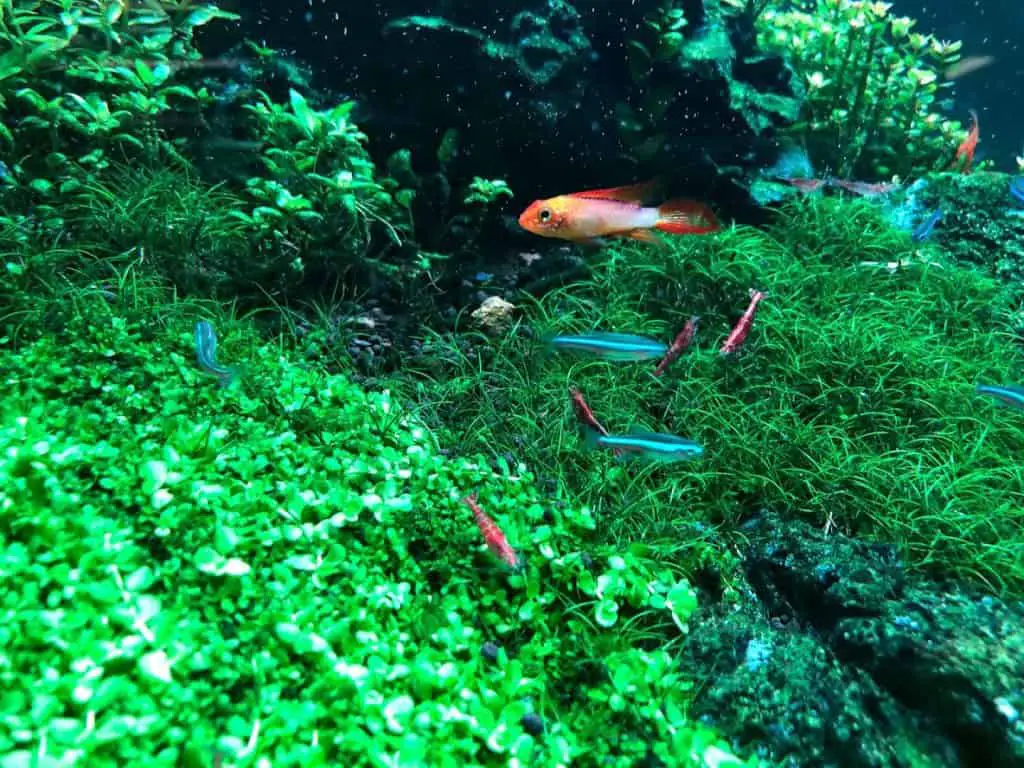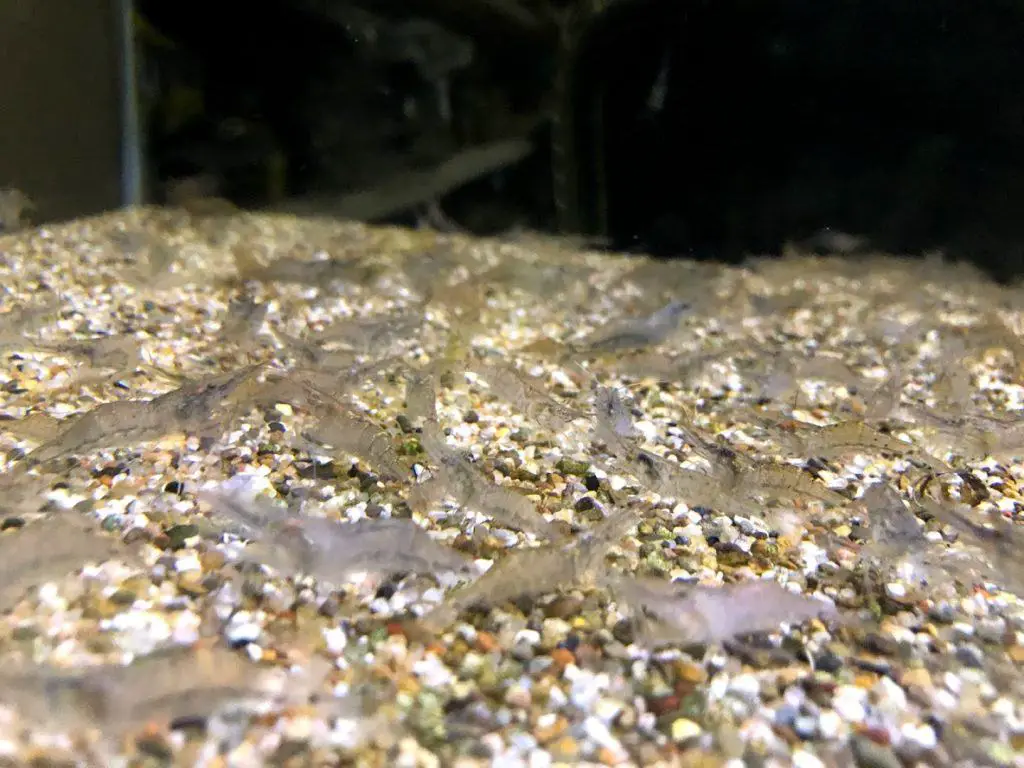An excellent starting-size shrimp tank is a 10-gallon tank. How many shrimp should you put in, and what should you do if you treat your shrimp well and your population explodes?
For a dedicated shrimp-only aquarium, you can keep 100 shrimp in a 10-gallon tank. However, it is recommended to hold a maximum of 50 shrimp. As a rule of thumb, this would be five shrimp per 1 gallon of water.
There is a difference between what you can and should put in your tank to make it livable for your pets. Some choices depend on personal preference, and some on the purpose of your aquarium. We will now look at what you must consider to make the best choice in your situation.
How Many Shrimp Can Thrive in What Kind of Setup
Determining how many shrimp to buy depends on what type of aquarium you want. There are various sorts of aquaria, with each their optimum starting number. It’s important to balance numbers depending on the desired purpose.
A Community Aquarium
The recommended number for a community aquarium will depend mainly on the number of other tankmates. For a nice mix, if you want some Amano shrimp to help clean up your tank, I would advise getting somewhere between 5 and 10. Amano shrimp can grow up to 2 inches or 5 cm.
If you go for dwarf shrimp, like cherry shrimp (get about 1.6 inches or 4 cm), you can get about 10 to 15. Amanos will be too big to be eaten by their tankmates, but tiny baby Cherries can. If there is enough cover for the baby shrimp to hide, their numbers can slowly grow to a nice colony without significant danger of sudden overpopulation.

A Breeding Tank
To breed or not to breed, a shrimp-only aquarium can comfortably house a hundred shrimp, varying from hatching to adult.
An excellent starting size of your shrimp colony will be about 10 to 20 specimens. Try to have some females even or a little over the number of males. Too few males or too large of a tank will mean it will be harder to find each other when it is time for breeding; a bigger aquarium isn’t necessarily an advantage here.
make sure they have plenty of biofilm to graze on
Planted vs. Non-Planted Shrimp Tank
When I say a planted aquarium or a non-planted, I don’t mean plants or no plants. A non-planted aquarium, for me, still has plants but focuses on the creatures in it. In contrast, when I talk about a planted aquarium, I think more about a beautiful aquascape with many plants where the shrimp and fish only play a small part in an underwater garden. In this case, I would get a few shrimp, maybe about 10, and keep the population from exceeding 20 to 25. Though I love shrimp, in this case, too many would diminish the overall scene you are trying to create.
Is There Such a Thing as Too Many Shrimp?
You can debate if there is such a thing as too many shrimp. If your population is exploding, congratulations, you are doing something right, and your little freshwater invertebrates are happy. Shrimp have a very small bioload, but something has to be done when it gets too crowded in the tank.
What to Do with The Overpopulation of Your Aquarium

Move All Your Shrimp to A Bigger Tank
One thing you can do is Move to a bigger tank. A 10-gallon tank is an excellent starting size, but having a bigger aquarium is nice if you are into the hobby and have the room and the time. Maybe it is also a great time to make that new aquascape on your mind.
I know I have more ideas of designs I like than I ever have room or time for, especially with all the beautiful pictures of aquaria you can find on the web inspiring you. An overcrowded aquarium can give you that reason you needed to justify to yourself to get that new setup. Just make sure you take the time to properly cycle the tank before you move your shrimp to their new dwelling.
Move Some of Your Shrimp to A Different Tank
If you have a large population, you have the numbers to be more selective with your breeding. It will greatly help if you have another aquarium for your different species or less desirable shrimp colors. This way, you can try to breed a better quality or a more beautiful shrimp color.
Remember, females tend to have more color than males. If you are breeding for color, ensure you are not removing all the males by selecting only the most colorful shrimp.
Sell Them Your Surplus Shrimp
When you search for “freshwater shrimp” on Craigslist or eBay, many people sell their shrimp. These can also be you. You could sell off some of your shrimp and make a little extra money to finance your hobby. If it goes very well and you have some sweet quality shrimp, you can even consider making a living off it. When you sell them, ensure you get the logistics figured out. Shipping live animals requires special care.
or eBay, many people sell their shrimp. These can also be you. You could sell off some of your shrimp and make a little extra money to finance your hobby. If it goes very well and you have some sweet quality shrimp, you can even consider making a living off it. When you sell them, ensure you get the logistics figured out. Shipping live animals requires special care.
Give Them Away Excess Shrimp
Give them to Friends and Family.
Get your friends and family involved in the hobby. Your surplus could be their starting colony. If you have some people in your vicinity who might like a beautiful addition to their homes, you can help them set up an aquarium. It is fun to help someone set up a nice tank, and you can also show them the ropes and enjoy the hobby together.
Trade Them on An Aquarium Forum
Trading them is a good option. You can exchange them with other enthusiasts, maybe even for the same species, to strengthen the gene pool. This way, you can try to breed with different or similar colors to make them even more beautiful. Otherwise, you might want to trade them for some nice plant someone has an abundance of or that little school of tetra’s you might wish to have as tankmates for your shrimp.
Bring Them to Your Local Pet Store
Some pet stores may give you money for them if they are of excellent quality and color. Others might give you some food or plant as compensation for your donation. Anything is better than throwing them away.
now, some words of caution
Releasing Pets in The Wild
There is one thing you should never do: NEVER release them in the wild! You might think the shrimp will be alright, and they might be, but whenever foreign species are introduced into an environment, the balance is disturbed and can lead to disaster for the native wildlife.
Invading species can bring unknown diseases with them, which can be devastating, and numbers can go wild without a natural enemy of the invading species.
Killer Shrimp
An example of invading species is the killer shrimp. Although this species is very different from the pet shrimp you find in the pet store, it is an excellent example of what can go wrong and how difficult it is to contain the problem once it’s there.
All the way from Eastern Europe, the species has swiftly spread throughout Western Europe. Invading and colonizing most freshwater bodies. Despite preventative measures, it now threatens the United Kingdom.

